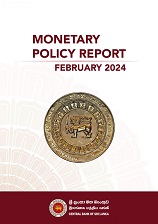Major Functions
Regulation & Supervision
Central Bank of Sri Lanka supervises and regulates major financial entities. Through regulation, the Central Bank sets standards or policies that it expects financial institutions to meet. In supervision, the Central Bank assesses the risks that financial institutions pose to financial system stability and, where necessary, takes action to reduce them.
Major regulatory requirements include;
(i) Minimum ratio of capital to total value of risk based assets
(ii) Minimum ratio of liquid assets to liabilities
(iii) Limit on volume of lending to a single borrower
(iv) Provision for bad and doubtful debts
(v) Submission of annual audited financial statements within a stipulated period
The regulatory requirements are intended to serve as prudential standards that help the institutions to mitigate some of the risks inherent in banking or finance business. Such regulations are determined in terms of the provisions of the relevant statutes. The supervision involves; oversight of financial institutions through off-site surveillance and on-site examinations.
Off-site surveillance is the examination of information received periodically (monthly, quarterly, half-yearly, etc.) from the institutions relating to their performances and financial status with a view to identifying early warnings of impending problems which can be resolved by taking early remedial action.
On-site examinations; under this, the Central Bank examiners periodically visit the institutions for examination of their books and accounts with a view to making an assessment of the operations of the institutions by verifying the compliance with prudential and regulatory requirements and assessing the various risks, i.e. credit risk, liquidity risk, market risk and operational risk and risk management capacity of the institutions. On the basis of the findings of these examinations, the Central Bank continuously communicates with the management of the institutions and requires them to initiate prompt actions to address the problems and weaknesses observed.
Macroprudential Surveillance
Macroprudential policy aims at increasing the resilience of the financial system as a whole to reduce the build-up of systemic risk (risks affecting the overall market) that can threaten the financial system stability. Macroprudential policy is set by identifying, monitoring and assessing risks jeopardising stability of the financial system in order to prevent or mitigate risks and ensure maintenance of stability in the overall financial system. For this purpose the Central Bank observes the financial and monetary system and the use of a specific set tools to limit systemic risks and disruptions to vital financial services required for carrying out of economic activities.
The analysis done for this purpose is known as macroprudential analysis. This is a method of economic analysis which assess the financial system as a whole to identify severe imbalances that arise in or are amplified by the financial system and the risks and vulnerabilities resulting from such occurrences.
Resolution of failing financial Institutions
Although no Central Bank or a government could guarantee safety of all transactions or institutions in the financial system, the Central Bank’s attempt is to ensure that the financial system as a whole remains stable. If there is any non-viable financial institution, the Central Bank as the resolution authority intervenes to resolve such institution safely, minimising the impact of possible adverse consequences of such institution’s failure on the broader economy. The Central Bank of Sri Lanka’s (CBSL) resolution approach includes proactive oversight, risk monitoring and crisis management, aiming to reduce disruptions from failing financial institutions. Empowered by the Central Bank Act No.16 of 2023, CBSL can manage distressed financial institutions without burdening taxpayers and instead holding shareholders and unsecured creditors responsible. CBSL’s resolution framework employs tools such as appointment of an administrator, asset transfers, mergers and liquidations to reinforce market discipline, uphold public trust and enhance the resilience of Sri Lanka’s financial system.
Financial Market Infrastructure Supervision
Financial Market Infrastructure (FMIs) play a key role in the smooth functioning of the economy and promote wider financial stability. Proper functioning of the market and the financial stability is dependent on the continued orderly functioning of the services provided by financial infrastructure. Hence, monitoring, managing and mitigating risk is a primary responsibility of financial market infrastructure providers.
Main types of infrastructure include;
a) Payment systems involving financial institutions
b) Securities settlement systems
c) Others such as central counterparties (currently there is no such entity falling under the purview of the Central Bank)
Functioning markets rely on the ability of the market infrastructure providers to ensure continued availability of required services. Payment systems facilitate businesses and other market participants to send and receive money as payments whether they are for goods and services they consume, money they lend or borrow or in making mere transfer payments. Securities settlement systems enable exchange of investments in equity or debt securities. Central counterparties offer guarantees for participants against defaults by the original counterparty.
In addition to its monitoring and regulatory responsibilities the Central Bank is currently providing payment systems infrastructure for large value rupee payments (Real Time Gross Settlement System – RTGS) and securities settlement system for Government securities (Scrip-less Securities Settlement System - SSSS).
Financial Safety Nets
Deposit insurance is a financial safety net mechanism that protects depositors from losses caused by a member financial institution’s inability to pay its debts. The Central Bank of Sri Lanka (CBSL) implemented a mandatory deposit insurance scheme under the enabling provisions of the Monetary Law Act No.58 of 1949, as the Sri Lanka Deposit Insurance Scheme (SLDIS) with effect from 01.10.2010 under the Sri Lanka Deposit Insurance Scheme Regulations No. 1 of 2010. The name of the Sri Lanka Deposit Insurance Scheme was amended as the Sri Lanka Deposit Insurance and Liquidity Support Scheme based on subsequent amendments in year 2013. This scheme was implemented in the interest of overall financial system stability of the country, and it promoted a mechanism to protect depositors from failure of financial institutions and thereby to support the stability of financial institutions by maintaining depositor confidence.
With the enactment of the Banking (Special Provisions) Act, No. 17 of 2023 (BSPA), the Deposit Insurance Scheme of Sri Lanka was legally instituted and named as the ‘Sri Lanka Deposit Insurance Scheme’ (SLDIS). Based on the BSPA, SLDIS is functioning with two main purposes of insuring the deposits made by the depositors in a Member Institution (MI) of SLDIS in order to compensate such depositors up to any maximum amount as may be determined by the Central Bank of Sri Lanka (CBSL) and establishing a system for providing appropriate financial assistance to facilitate the transfer of assets and liabilities of a licensed bank as a resolution measure subject to safeguards.
Presently, the MIs of SLDIS comprises all licensed commercial banks, licensed specialised banks and licensed finance companies. Effective from 01.04.2021, in the event the licence of a MI is cancelled by the Monetary Board/Governing Board of CBSL, eligible depositors are compensated up to a maximum of Rs. 1,100,000 per depositor, per institution by SLDIS.










